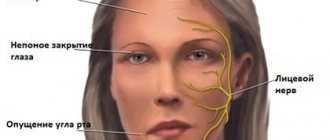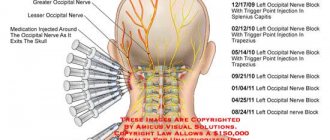Learn more about diseases starting with the letter “P”: Panic attacks; Duchenne-Erb's palsy; Todd's palsy; Parasomnias; Paroxysmal hemicrania; Paroxysmal myoplegia, Paroxysmal positional vertigo; Peripheral autonomic failure; Hepatic encephalopathy; Pineoblastoma; Pineocytoma; Writer's cramp; Platybasia; Plexites; Brachial plexitis; Humeroscapular periarthrosis; Pneumococcal meningitis Pneumocephalus; Subacute sclerosing panencephalitis; Spinal cord injury.
Todd's palsy is a temporary, transient condition of central weakening or paralysis in one or both limbs that appears after the end of an epileptic seizure. It is a sign of depletion of the central nervous system and can signal the presence of a tumor in the brain and a disruption of metabolic processes.
Diagnosis of post-epileptic paralysis is carried out by excluding acute disturbances in cerebral blood flow after MRI and CT scans of the brain. For additional diagnostic purposes, electroencephalography, examination of cerebral vessels, and examination of internal organs are prescribed.
Treatment is not prescribed if underlying diseases are not detected. In this case, epilepsy is treated.
Definition
Todd's palsy is a transient condition that develops after an epileptic seizure. Patients experience paresis or paralysis of the limbs on one side or both. Such paralysis is the first warning of exhaustion of the nervous system and may be a symptom of cancer or metabolic disorders.
Paralysis can be diagnosed only after magnetic resonance imaging, which will rule out cerebral circulatory disorders and organic damage to nervous tissue. Additionally, the doctor may prescribe electroencephalography (EEG) to identify foci of epilepsy, Dopplerography of cerebral vessels, angiography and other tests.
If the cause of the seizures is not found, then treatment is reduced to stopping the epilepsy.
Links[edit]
- Todd RB (1849). “On the pathology and treatment of convulsive diseases.” London Med Gaz
.
8
: 668. - Pierce JM (March 1994). "Robert Bentley Todd (1809-60) and Todd's palsy". J. Neurol. Neurosurgery. Psychiatry
.
57
(3): 315. DOI: 10.1136/jnnp.57.3.315. PMC 1072820. PMID 8158178. - ^ a b
Gallmetzer P, Leitmezer F, Serles W, Assem-Hilger E, Spatt J, Baumgartner S (June 2004).
"Postictal paresis in focal epilepsy - frequency, duration and causes: a video-EEG monitoring study." Neurology
.
62
(12):2160–4. DOI: 10.1212/wnl.62.12.2160. PMID 15210875. - Uptodate: First seizure assessment in adults
- Gallmetzer R, Leutmezer R, Serles W, Assem-Hilger E, Spatt J, Baumgartner S (June 2004). "Postictal paresis in focal epilepsy - frequency, duration and causes: a video-EEG monitoring study". Neurology
.
62
(12):2160–4. DOI: 10.1212/wnl.62.12.2160. PMID 15210875. - Oestreich L, Berg M, Bachmann D, Burchfiel J, Erba G (1995). "Contralateral rectal paresis in complex partial seizures." Epilepsy
.
36
(7): 671–5. DOI: 10.1111/j.1528-1157.1995.tb01044.x. PMID 7555983. - Mikati M, Magure N, Barlow S, Ozelius L, Breakefield H, Klauck S, Korf W, O'Tuama S, Dangond F (1992). “Autosomal dominant intermittent hemiplegia syndrome: clinical manifestations simulating intractable epilepsy; chromosomal studies; and physiological research." Neurology
.
42
(12):2251–7. DOI: 10.1212/wnl.42.12.2251. PMID 1361034. - name = "Farrell et al., 2016" > Farrell, Jordan S; Gaxiola-Valdez, Ismael; Wolf, Marshal D.; David, Lawrence S; Dika, Haruna I; Geeraert, Bryce L; Wang, X Rachel; Singh, Shaylee; Spanswick, Simon S; Dunn, Jeff F; Antle, Michael C; Federico, Paolo; Teskey, J. Campbell (2016). "Postictal behavioral disturbances arise from severe, prolonged hypoperfusion/hypoxia that is COX-2 dependent". eLife
.
5
. DOI: 10.7554/eLife.19352. PMC 5154758. PMID 27874832. - Sylaja PN, Dzialowski I, Krol A, Roy J, Federico P, Demchuk AM (2006). "The role of CT angiography in decision-making for thrombolysis in patients with suspected seizure at stroke onset". Stroke
.
37
(3):915–7. DOI: 10.1161/01.STR.0000202678.86234.84. PMID 16456124. - Nelson K, Ellenberg J; Prognosis in children with febrile seizures Pediatrics; 61, 5: 720-727
Causes
Todd's paralysis remains one of the medical mysteries. And without knowing the cause, doctors cannot develop a mechanism for dissociating the pathological process in order to cure it. Based on indirect evidence, doctors have several assumptions regarding the nature of the disease. According to the most progressive theory, the “phenomenon of inhibition of the nervous system” manifests itself in the form of paralysis. It is associated with impaired neurotransmitter transmission.
In addition, there are several other reasons:
- several epileptic seizures in a row; - brain exhaustion; - malignant neoplasm of the central nervous system; - inflammation of the brain substance, especially of viral etiology; — uncoupling of lipid metabolism; - presence of ischemic strokes in the past; - diseases of the heart and blood vessels.
Factors causing Todd's palsy
The causes of Todd's palsy and the mechanism by which the condition develops are under study. Scientists in the field of medicine and physiology have determined the relationship between post-epileptic movement disorders and immoderately progressive inhibition processes originating in the central nervous system.
Paralysis is the result of neurotransmitter deficiency and weakening of brain functions. This statement is not without foundation, since Todd's palsy in most cases is recorded with:
- organic diseases of the brain – encephalitis;
- cerebrovascular accidents;
- tumors of the central nervous system;
- severe primary diseases - liver failure, chronic renal failure, cardiovascular failure, diabetes mellitus, tuberculosis, septic conditions.
The paralytic state is caused by dysmetabolic, ischemic and toxic effects on the central nervous system. Todd's paralysis usually occurs after an epileptic seizure that lasts more than half an hour. Laboratory studies show that lipid metabolism is disrupted in patients, triglyceride levels increase, and cholesterol saturation decreases.
Symptoms
How does Todd's paralysis manifest itself? The symptoms initially resemble those of an epileptic seizure. For those around you, watching an attack can be quite difficult, since they have no opportunity to help the patient. But even after the cramps end, the person cannot fall asleep and experience blissful oblivion. On the contrary, he freezes and cannot move his arms and legs.
How long will Todd's paralysis last? Symptoms (photos of patients can be traumatic and are considered unethical) sometimes persist around the meshes or more. Doctors most often note the appearance of unilateral paralysis or paresis. Over time, the motor blockade passes without leaving any consequences. Medical periodicals record cases of Todd's paralysis with visual and articulation impairments.
At the first encounter with this pathology, the symptoms can be regarded as manifestations of a stroke, but after all the necessary diagnostic measures have been carried out, the primary diagnosis is removed, and the rapid regression of symptoms confirms the version of paralysis.
Presentation [edit]
Robert Bentley Todd
The classic presentation of Todd's paresis is temporary weakness of the hand, arm, or leg following focal seizure activity in that extremity. Weakness can range from mild to complete paralysis. [ citation needed
]
When seizures affect areas other than the motor cortex, other temporary neurological deficits may occur. These include sensory changes if the seizure involves the sensory cortex, visual field defects if the occipital lobe is involved, and aphasia if speech, comprehension, or fibers are involved. [ citation needed
]
Postictal paresis (PP), although familiar to neurologists, has not been well studied. One retrospective observational study included 328 selected patients aged 16 to 57 years who had long-term video electroencephalogram (EEG) monitoring for treatment-resistant epilepsy and focal seizures; patients with nonepileptic seizures, status epilepticus, and Lennox-Gastaut syndrome were excluded. [5] The following observations were made: [ citation needed
]
- PP occurred in 44 patients (13.4%).
- The PP was always unilateral and always contralateral to the seizure focus.
- The average duration of PP was 174 seconds (range 11 seconds to 22 minutes).
Of all the attacks followed by PP, the following features were noted: [ citation needed
]
- Overt ictal motor activity was observed in 78% (Todd's palsy is more common after any clonic seizure activity) [3]
- Very weak ictal motor activity was observed in 10% of patients.
- Ictal motor activity was absent in almost 10 percent.
- The most common finding of ictal lateralization was unilateral clonic activity in 56% of cases.
- Ictal dystonic posture occurred in 48 percent.
- Immobility of the iliac limb occurred in 25% of cases.
The results of this study are valuable because few other data exist on the frequency, duration, and characteristics of attacks associated with PP. However, the study is likely biased by including only patients with intractable seizures who underwent video-EEG monitoring, and the results cannot be extrapolated to the general epilepsy population. [ citation needed
]
Other postictal neurological findings that are not related to activity in the area affected by the seizure have been described. They are thought to be caused by a different mechanism than Todd's paresis, including paralysis of the contralateral limb [6], as well as rare genetic causes of hemiplegia and seizures. [7]
Diagnostics
What should be done to confirm Todd's paralysis? The signs of the disease are quite vague. It is necessary to exclude all other pathologies to be sure of the diagnosis. The first step is to determine the severity of the observed condition and the level of muscle paralysis. To do this, conduct a physical examination and compare the data obtained with a five-point scale:
- Five points means a complete absence of symptoms, the patient’s muscles are in a state of physiological norm.
- Four points – strength indicators are slightly reduced, but the activity of the limbs is still maintained. The patient calmly overcomes the resistance of the doctor's hand.
- Three points - stiffness of the victim’s muscles is noticeable to the naked eye, but the patient is still able to make voluntary movements, although not as quickly as with four points. It becomes more difficult to overcome the resistance of the doctor's hand.
- Two points - the Earth's gravity becomes an insurmountable obstacle for such a patient.
- One point – complete muscle paralysis is observed.
After the examination, the doctor collects a thorough history from the patient’s relatives, studies the medical record, and prescribes a computed tomography or magnetic resonance imaging scan. To exclude a stroke, the patient undergoes angiography to identify the focus of epilepsy (if there is a history of one), and electroencephalography is prescribed. To determine concomitant pathologies, ultrasound examination of the heart and electrocardiography are performed.
Only having all the results, the doctor can choose the most probable one among all the possible diagnoses and begin therapy.
Treatment
How can Todd's paralysis be reversed? The treatment, although purely symptomatic, has low effectiveness, since it is difficult to accurately establish the cause of this condition. Therapy depends on the level and severity of paralysis.
If movement disorders are minor, then specific treatment is not required. The symptoms will go away on their own within a few hours or days. For more profound disorders, benzodiazepine drugs are used, such as Midazolam, Diazepam, Lorazepam, Fosphenytoin or Phenytoin. Each of them stops convulsive attacks and their consequences. When prescribing them, it is necessary to remember that abrupt withdrawal of antiepileptic drugs can also provoke an attack.
There are contraindications for prescribing these drugs. First of all, this is, of course, intolerance to the components of the drug, as well as a history of closed-angle glaucoma and drug or alcohol addiction. In addition, renal function plays an important role, since the drug is mainly excreted in the urine.
Prevention
There is no way to prevent Todd's post-seizure paralysis. This condition has not yet been fully studied, so specific prevention, as well as treatment, cannot be developed. Perhaps some time later, when the capabilities of medicine become even greater, we will be able to take some steps to eliminate this pathology.
Today, doctors give very vague advice, such as maintaining a healthy lifestyle, proper nutrition, giving up bad habits and moderate physical activity. In addition, you should not forget about periodic preventive examinations, because any disease is easier to prevent than to treat.
Forecast
Todd's palsy can have a good or bad prognosis. It all depends on the severity of neurological symptoms and the duration of paresis or paralysis. If a neurologist gives a rating of “three” or “four” on a five-point scale, then in this case the disease does not cause significant concern, and the prognosis for life and health is favorable. The body quickly recovers after attacks; the condition does not require drug intervention.
If the paralysis lasts a long time, the functions of the limbs are restored for a long time, and the number of attacks becomes more frequent over time, then the prognosis for life is, of course, unfavorable.
Consequences and prognosis
If the symptoms of paralysis are mild, then there is no need to take medications.
This form of the disease is not a threat, but rather is beneficial. All pathological symptoms will soon disappear and the body will fully recover. The situation is a little more complicated if the symptoms of Todd syndrome are long-lasting and full-blown. Severe manifestations of the disease can negatively affect human health.
However, muscle weakness will disappear, albeit not so quickly, but muscle strength will be fully restored and they will be able to function properly. In this case, it is more difficult for victims to predict epileptic attacks, since they can happen at any inopportune moment.
Latest research
Right- and left-sided Todd's palsy can progress, and over time muscle weakness remains, even after long-term treatment. For such patients, as well as other paralyzed people, science has a couple of revolutionary ideas to offer. The first of these is the creation of prosthetics. Today, there are prototypes of bionic limbs controlled by the power of thought, that is, the device connects to the nervous system and perceives nerve impulses, deciphering the signals.
The second method is rather biological. It is based on the restoration of nerve endings using stem cells. Since they have a tendency to almost endless division, and can also differentiate into any cell of the human body. Experiments are currently being carried out on laboratory animals, but if they are successful, one can hope for a significant breakthrough in the treatment of neurological diseases.










